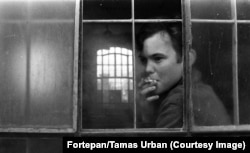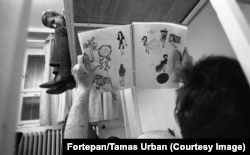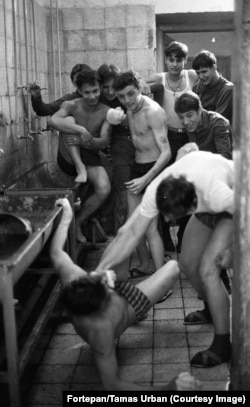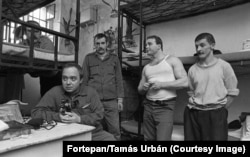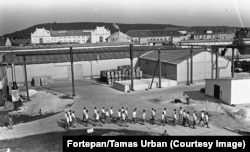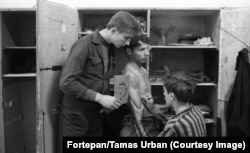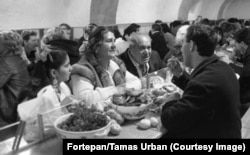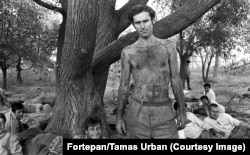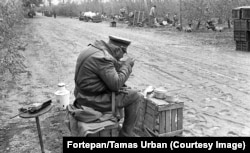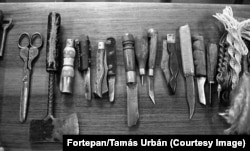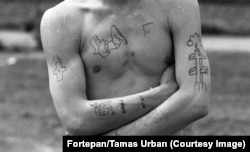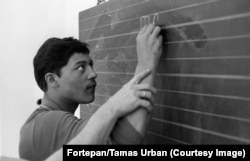When photojournalist Tamas Urban sent a request to document life inside the Aszod juvenile detention center in the early 1970s, he had little hope of gaining access.
No one had entered with a camera before and whatever happened behind the high walls of the correctional facility near Budapest was unlikely to fit the image that Hungary’s communist government wanted to project to the world.
But the newspaper Urban worked for at the time was the mouthpiece for the local branch of Hungary’s communist government. The young photographer’s moon-shot request was “treated as if it was an official request from a member of the party,” the Hungarian photographer explained to RFE/RL from his home in Budapest, “so doors flew open and everyone showed the greatest cooperation.”
Over several months Urban photographed and became close to the young men -- many of whom were locked in the facility for violent crime. Then, after he organized an exhibition of the photos he had made, inside the same detention center, the photographer’s remarkable run of good luck ended.
As a small crowd gathered to look over the stark images, a local communist bureaucrat “intervened in a style that did not brook any opposition,” Urban recalls.
The official announced the prints needed to be taken down and would not be allowed leave the detention center.
“I will never forget those minutes, the first exhibition of my life, which I’d worked on for several months, that won the praise of visitors and journalists at the opening, this material was simply deemed ‘not fit for publication’ by an official of the ministry,” the 78-year-old recalls. “I remember going home heartbroken. I vowed never to set foot in the institute, nor even the town of Aszod again. I was defiant.”
Urban’s relationship with the Aszod facility stopped dead, but his time spent in detention centers had just begun.
Over the following decades, as Hungary headed through various phases of the “goulash communism” that followed the nightmare years of early Stalinist-style left-wing authoritarianism, Urban built a highly successful photography career.
In the 1980s, Urban was an obvious choice to photograph a series of books that were planned by a publishing house to show life inside Hungary’s prisons.
The images inside prisons that Urban made are remarkable for accessing not only the impenetrable concrete and steel heart of Hungary’s communist state, but in many cases, the very human hearts of the men and boys locked inside.
Urban used a bold psychological technique to gain access to many of the inmates he photographed. After his arrival to a new prison had been announced by guards, he then simply wandered around without doing anything.
“I knew that prisoners would never allow me to take their photo if I asked -- not because they’re shy, but because they are part of a system in which they can almost never say ‘no,’ so when they get the chance, they will,” the photographer explained to a Hungarian journalist.
Eventually, after confusing the assembled prisoners, as well as his prison guard escort with his aimless wandering, someone invariably piped up.
“The braver convicts would call me over to take a photo of them,” he says.
Once it was the prisoners themselves asking to be photographed, Urban says, “I had already won them over and they practically lined up to be photographed.”
Over the past several years, the award-winning photographer has been scanning and releasing his work to the world, largely through the Hungarian photo archive Fortepan, where thousands of his images are available.
Urban is close friends with Fortepan’s founder, Miklos Tamasi, and Urban says he felt his archival work would be “in the best place in his hands.”
Thousands more of Urban’s images are yet to be released, many of them taken through the 1990s in Hungary, a time of surging crime rates and instability comparable to the turbulence faced by many former communist states through the same decade.
In 2016, Urban was contacted by the managers of the Aszod juvenile detention center, where his journey through communist Hungary’s correctional facilities began. Staff at the Aszod site had discovered the pile of "canceled" photos he had made more than 40 years earlier stacked up under “the broken leg of a piano.”
The discovery of the Aszod images were enough for Urban to break his long boycott of the town and the retired photographer traveled to the detention center with his son, Adam Urban, an acclaimed photographer in his own right.
“Over a few months, Adam got to know the institute himself. Then, within a couple of years, he made his own photos there,” the older Urban told RFE/RL.
In 2018, Adam and Tamas Urban held a joint exhibition of their works made inside the Aszod facility.
Tamas says his career as a photojournalist, which often brought him face-to-face with tragedy and human wickedness, took a heavy personal toll, and he was medicated for depression. The cost, however, was worth it, he says.
He believes that, if not for his camerawork, the aspects of society he captured so expertly, particularly of life inside the prisons of communist Hungary “would be invisible today,” he said.





